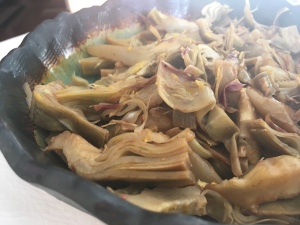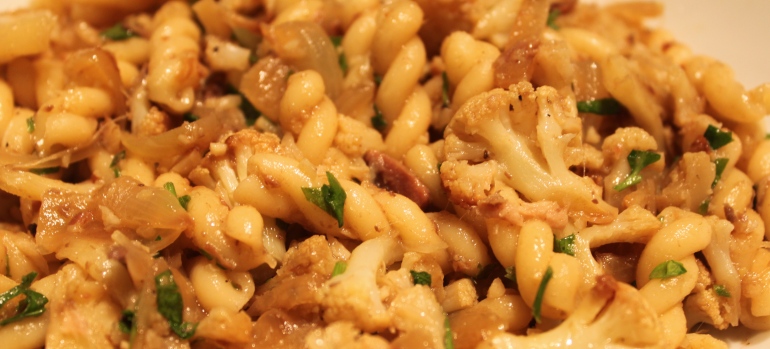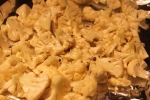
Italian Supper Club I: Here’s the very delicious Artichoke and Trofie Pasta Recipe; courtesy of my friend’s James’ Italian friend Giampiero ; Grazie and Mangiamo!
Ingredients: 2 Lemons 4 to 5 Artichokes (firm, tight, green, preferably Romanesco type)2 to 3 cloves of garlic, peeled 1 to 2 tsp Peperoncino (red chili pepper) flakes, 2 to 3 Anchovies (preserved in oil), 1-2 cups Warm Chicken soup stock (homemade or store-bought*), 1 cup dry white wine, 500 gr Trofie dry pasta, grated Parmigiano-Reggiano and Pecorino Romano cheese, 3 to 4 Tablespoons extra virgin olive oil, sea salt (for pasta cooking and seasoning).
*Vegetarian stock can replace chicken stock to make this dish vegetarian; chicken or vegetarian stock cubes can be used also. Anchovies are used to “season” the dish so adjust the salt accordingly (OO).
TIPS: This recipe serves 5 (100g pasta each as an appetizer); the usual size 500 g package of pasta is good for 5 to 6 people, depends on what is being used to go with it.
We used the same recipe, omit the pasta and turn the artichokes into antipasti; we just quartered the artichokes and serve it room temperature. The lemon water prevents oxidation; it also removed the somewhat “muddy” flavor of artichokes and add brightness to the dish. Trofie pasta is selected as the shape goes with the sliced artichokes.

Method:
- Zest the two lemons and reserve the zest in a small bowl for later use.
- Prepare a large bowl with cold water. Cut the two zested lemons in half and carefully squeeze the juice into the water being careful not to include the seeds. Drop in the seedless peels in as well. The lemon water is to prevent the artichokes to oxidize.

3. Using a paring knife, carefully clean and trim the artichokes, pulling away the dark and hard outer leaves. Cut off the end of the stem, slice away the darker green outer layer of the stem. Carefully pare away any remaining dark green layer between the peeled stem and the edge of the base. Cut off about 1/3 to a half of the pointy leaf ends. Be careful when paring and not to cut yourself.
4. Slice the trimmed artichoke in half lengthwise and then into quarters and carefully remove the hairy choke, pulling out any pointy interior leaves in the process. Drop the trimmed artichoke (carciofi in Italian) in the cold lemon water and repeat the process until completed. When all of the have been properly trimmed and quartered, take each quarter and slice thinly lengthwise, returning the sliced artichokes into the acidulated water immediately.
5. Put a large pot of salted water (sea salt) on to boil.
6. Warm the chicken / vegetarian stock in the sauce pan; keep it in low simmer (this step will be omitted if you are using chicken /vegetarian stock cube and those can be added directly into the pan for flavoring).
7. Using low heat, add 2 (to 3 TBS) olive oil to a large saute pan or wok (in Italy they have a large rounded pan with a handle called a Salta pasta); gently saute the garlic and peperoncino (red pepper flakes).
8. Add the drained artichoke slices and raise the heat to medium, Stir constantly (without breaking the artichokes). After 2 to 3 minutes, add the anchovies to the side of the pan, carefully mashing them so that they completely dissolve in the oil.
9. Add the warm soup stock a little at a time (when cooking always add warm stock to avoid temperature fluctuations) and stir in the white wine. The stock will add another level of flavor to the artichokes; let hte mixture simmer in low heat. The artichokes will absorb the liquid, you don’t want the sauce to be “watery”.
10. While sauce is simmering, throw the trofie pasta in to the boiling water and cook for at least one to two minutes less than indicated on the instructions. Do not Toss the pasta water!

11. Reduce the heat a bit lower (medium low) for the artichokes, cover and cook until the artichokes are almost tender. They should be al dente by the time the pasta is ready. Taste the artichokes and see if they need any salt, the anchovies should be enough for flavoring, otherwise add a little salt if needed.
12. Using a strainer or a spider to lift the al dente pasta out of the cooking water and toss into the pan with the artichokes. Add a ladle or two of the pasta cooking water (acqua di cottura), stir and fold gently to ensure the water mostly evaporates. The cooking water is what makes the sauce creamy!
13. Add a couple of handfuls of grated parmesan and pecorino cheese to the artichoke /pasta mix. Stir gently to integrate the cheese with pasta, then serve hot in individual bowls. Top each with some of the lemon zest, a drizzle of extra virgin olive oil and more of the grated cheese if desired. Mangiamo!








